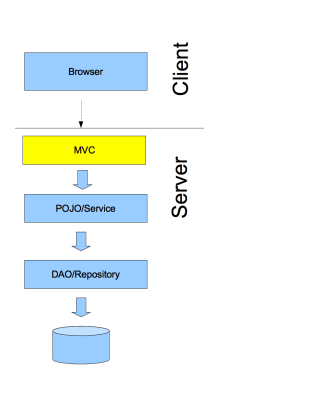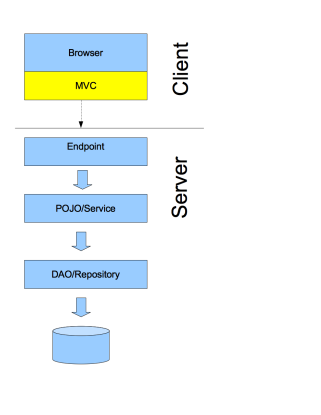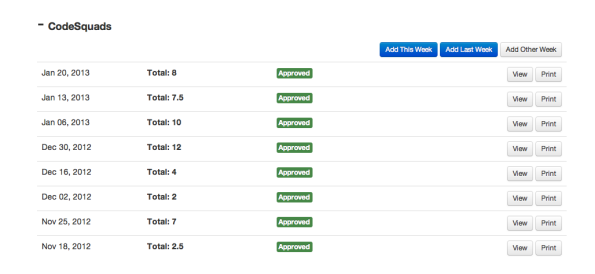The Keyhole team has had recent engagements that involve applying HTML5 technology to create rich client web applications. In order to explore and validate application architecture design patterns and best practices in this area, and as they say “eat our own dogfood,” we have gone through the process to rewrite our existing internal timesheet tracking system.
The old, legacy system was implemented as Java portlets deployed to a Liferay portal. We implemented the new application with an HMTL5-based front end that accesses server side Java APIs. The timesheet system has common functionality that a typical enterprise application development team might encounter, so this blog will walk through how we built and architected this application.
Why HTML5/Javascript
Before we jump into the building process of this application, let’s first clarify what we actually mean by HTML5. HTML5 is a W3C specification that is being widely adopted by most, if not all, browser manufacturers. The features in this specification facilitate new elements: local storage, canvas, full CSS3 support, location APIs, new attributes, audio/video services, among others. These features will be important to enterprise development. An immediate benefit is the numerous JavaScript/CSS frameworks that enable the creation of a responsive rich user interface. Packaging all of these together, we simply refer to this as HTML5.
More than just the new HTML5 features, there are a couple of key reasons driving this architecture shift to JavaScript. First, browsers and JavaScript engines have been optimized for performance, so it’s feasible to deliver and process a plethora of JavaScript code. Bandwidth is another issue, along with connectivity. Most desktops can assume connectivity and access to bandwidth. However, mobile devices can’t always assume connectivity, and having to process HTML on the server can be make application sluggish.
Also, the biggest factor is that many JavaScript and CSS frameworks exist that allow a rich and device-responsive user interface to be created in an agile way. It’s feasible to use these frameworks to implement a single web user interface that is satisfactory for the desktop, tablets, and mobile devices.
Case Study Application
This newly-created web application is how Keyhole Software employees keep track of time worked. It is accessible from a desktop, tablet, and any mobile device with a browser. Additionally, we have implemented Android and iOS native applications that interact with the same JSON endpoints that the browser-based UI uses. There are more details about that further down the article.
Here are some use cases (accompanied by screen shots) for application functionality:
LDAP-based Authentication, using Atlassian Crowd:

Once authenticated, users can create and edit time sheet entries by week. Administration roles have access to reporting features and timesheet approval options. Reports are defined as Eclipse BIRT reports.

User identification, as well as the applications and roles they have the authority to access, are stored in an LDAP repository. Administration roles can maintain groups or users.

How We Built It
The application’s server side portions are built using JEE technology. The application is contained inside an Apache/Tomcat application server hosted on an Amazon EC2 instance. System data is stored in a MySQL relational database. The application’s user interface applies the following frameworks:
Front End
- Bootstrap – an open source framework for the UI component, the look and feel of the application. It includes styling for typography, navigation and UI elements. One of the main reasons we chose Bootstrap as a viable solution was its responsive layout system, with which the user interface automatically scales to various devices (i.e. desktop, tablet, mobile).
- jQuery, Require.js, and Backbone.js – JavaScript frameworks that provide Document Object Model (DOM) manipulation, dependency management and modularization, and Model View Controller and HTML templating support. And, all of them reside within a client browser.
Server Side
Application logic and data access to MySQL was implemented as server side Java endpoints. These endpoints were accessible via RESTful URLs via HTTP. Endpoints were created using Java technology and contained by the JEE application server. Plain old Java objects (POJO) modeled application data entities, which were mapped to the relational data source using an Object Relational (O/R) mapper.
The following server side frameworks were used:
- khsSherpa – a POJO-based RESTful JSON endpoint framework. Provides a built-in authentication mechanism.
- Spring IOC and Authentication – Spring’s dependency management was used to configure application logic and and data access layers. Spring Authentication was used to authenticate with LDAP. Additionally, the Spring LDAP template was used to access and update the LDAP repository.
- JPA and Hibernate – a Java persistence architecture to map and interact with MySQL using Java JDBC drivers.
Development Environment
Development was performed using Spring STS and the Eclipse IDE with a Tomcat application server. A cloud-based development EC2 MySQL instance was used.
Application Architecture Shift
In order to generate a HTML user interface, traditional Java web application architectures typically build the MVC server side using either JSP or a server side HTML template framework. The legacy timesheet application used portlet JSPs. In our new application, a POJO-based application model is used to model the application data entities. These are mapped to a data source and persisted using the traditional DAO pattern. Services are designed to “service” the user interface. Controllers handle navigation and views render an HTML user interface. This is all performed server side by an application server. Here’s a picture:

The architecture shift involves moving the server side MVC elements to the browser implemented in JavaScript, HTML, and CSS, using the frameworks previously mentioned. Here’s the new picture:

Server Side Implementation
Server side components are implemented using Java JEE components and are deployed as a WAR file component to an application server. Application logic and data access to the timesheet system’s relational data store follows a layered application architecture.
Service/POJO/Data Access
Let’s start looking at the server side elements of the application architecture. Server side Services are implemented as Spring framework service classes. They provide an API for POJO models to be created, retrieved, updated, and deleted (CRUD). JPA is used as the persistence mechanism. Since this does not need to be “pluggable,” references to the JPA entity manager are directly done via Spring in the service. For the sake of correctness, the EntityManager reference is arguably a DAO. If we anticipated a data source change, we would have implemented a contract/interfaced DAO for plug-gability. We also used the Spring Data framework for some services that required more SQL queries. The agileness, some might call magic, of Spring Data’s ability to dynamically implement code is very agile. The service implementation for weekly timesheet entries is shown below:
@Service
public class EntityWeekService extends BaseServer {
@PersistenceContext
private EntityManager entityManager;
private Collection<?> buildWeek(List<Object[]> results ) {
List<Map<String , Object>> list = new ArrayList<Map<String,Object>>();
for(Object[] o: results) {
Map<String, Object> map = new HashMap<String, Object>();
list.add(map);
map.put("WeekName", o[0]);
map.put("Year", o[1]);
map.put("Week", o[2]);
map.put("Hours", o[3]);
map.put("Status", o[4]);
}
return list;
}
public Collection<?> getWeek(Status status) {
Query query = entityManager.createNativeQuery(
"SELECT * " +
"FROM Entry " +
"WHERE Entry.user_id = :user and Entry.client_id = :client and WEEK(Entry.day) = :week");
query.setParameter("client", status.getClient().getId());
query.setParameter("user", status.getUser().getId());
query.setParameter("week", status.getWeek());
List<Object[]> results = query.getResultList();
List<Entry> list = new ArrayList<Entry>();
for(Object[] o: results) {
Entry entry= new Entry();
entry.setId(((BigInteger) o[0]).longValue());
entry.setDay((java.util.Date) o[1]);
entry.setHours((Double) o[2]);
entry.setNotes((String) o[3]);
list.add(entry);
}
return list;
}
public Collection<?> getMyWeek(User user, Client client) {
Query query = entityManager.createNativeQuery(
"SELECT " +
"CONCAT(YEAR(day), '/', " +
"WEEK(day)) AS week_name, " +
"YEAR(day), WEEK(day), " +
"SUM(hours), " +
"status " +
"FROM Entry LEFT JOIN Status on Entry.user_id = Status.user_id and Entry.client_id = Status.client_id and YEAR(day) = Status.year and WEEK(day) = Status.week " +
"WHERE Entry.user_id = :user AND Entry.client_id = :client " +
"GROUP BY week_name " +
"ORDER BY YEAR(day) DESC, WEEK(day) DESC " +
"LIMIT 8");
query.setParameter("client", client.getId());
query.setParameter("user", user.getId());
List<Object[]> results = query.getResultList();
return buildWeek(results);
}
@Transactional
public Entry update(Entry entry) {
Here’s a service implementation responsible for retrieving and persisting Client data. This service references a Spring Data ClientRepository interface:
@Service
public class ClientService extends BaseServer {
@Autowired
private ClientRepository repository;
public Collection&>Client&< getMyClients() {
return repository.findByActive(true, new Sort(Sort.Direction.ASC, "name"));
}
public Collection&<Client&>getAllClients() {
return repository.findAll(new Sort(Sort.Direction.ASC, "name"));
}
public Client getById(long id) {
return repository.findOne(id);
}
public Client save(Client client) {
return repository.save(client);
}
}
RESTful JSON/Endpoints
Service methods are accessed using a RESTful URL pattern and return JSON data payloads. This is accomplished using the open source framework khsSherpa. Endpoints are defined by creating Endpoint classes that are annotated with the khsSherpa framework annotations. Methods in the endpoint class can be annotated as with RESTful URL actions. The framework handles parameterization and serialization of object and arguments automatically. A partial endpoint implementation that fronts the weekly timesheet service is shown below with the RESTful URL action methods bolded:
@Endpoint
public class EntryWeekEndpoint {
private SimpleDateFormat formatter = new SimpleDateFormat("yyyy-MM-dd");
@Autowired
private EntityWeekService entityWeekService;
@Autowired
private EntryService entryService;
@Autowired
private ClientService clientService;
@Autowired
private UserService userService;
@Autowired
private StatusService statusService;
@Action(mapping = "/service/my/week/client/{id}", method = MethodRequest.GET)
public Collection<?> myClientWeeks(@Param("id") Long id) {
return entityWeekService.getMyWeek(userService.findByUsername(SecurityContextHolder.getContext().getAuthentication().getName()), clientService.getById(id));
}
<strong>@Action(mapping = "/service/my/week/client/{id}/times/start/{start}/end/{end}")</strong>
public Collection<Entry> getWeekTimes(@Param("id") Long id, @Param("start") String start, @Param("end") String end) throws ParseException {
return entryService.getBetween(userService.findByUsername(SecurityContextHolder.getContext().getAuthentication().getName()), clientService.getById(id), formatter.parse(start), formatter.parse(end));
}
Endpoints are accessed with the following following URLs:
This URL return employee timesheets for current time period in JSON format:
http:
This URL returns employee timesheets for data range in JSON format:
http:
LDAP Authentication
Employees are authenticated into the application against a Crowd LDAP user repository. This is accomplished using Spring Authentication frameworks and a LDAP template. The khsSherpa framework is integrated with Spring Authentication, and therefore only LDAP configuration context files are required. An example Spring context file is shown below:
<security:ldap-server id="contextSource"
url="ldap://<server>:<port>/dc=keyholesoftware,dc=com"
manager-dn="cn=ARootUser,cn=Root DNs,cn=config"
manager-password="<password>" />
<bean id="ldapTemplate" class="org.springframework.ldap.core.LdapTemplate">
<constructor-arg ref="contextSource" />
</bean>
<bean id="authenticatedVoter" class="org.springframework.security.access.vote.AuthenticatedVoter" />
<bean id="roleVoter" class="ws.directweb.timesheet.auth.CustomRoleVoter">
<property name="rolePrefix" value="DW_" />
</bean>
If authenticated, a random token is returned and must be used by subsequent requests. The token is associated with a timeout and lifetime period.
Authenticated URLs
The JSON endpoint framework provides a token-based authentication mechanism. Authenticated RESTful URLs must be accessed with a valid token and User ID, which are stored in the request header. The khsSherpa framework automatically authenticates token and ID against a pluggable token manager. Non-authenticated public endpoints can also be defined. In the case of our time sheet application, only authenticated URL’s are required. The endpoint framework allows endpoints to be secured across the board, using a property file, or at a endpoint/class level. Here’s a snippet of a non-authenticated endpoint:
@Endpoint(authenticated = false)
public class GroupEndpoint {
@Autowired
private LdapDao dao;
@Autowired
private GoogleService googleService;
@Action(mapping = "/service/groups", method = MethodRequest.GET)
public Collection<LdapGroup> getGroupss() {
return dao.getGroups();
}
...
Unit Testing
To test server side Service/DAO implementations, we used JUnit. Also, since the endpoints are POJO-based, they can be tested without a server, using JUnit.
Continuous Build and Deploy
Git is the source repository we use for this internal development project. We use Github to host our repositories. Git works well as we have a distributed work force. To execute a Maven package goal, we have installed a Hudson server instance on an Amazon EC2 instance with a Hudson project configured. This goal compiles, builds, tests and produces a WAR file, which is then deployed to a test application server.
Client/Browser Side User Interface 100% Javascript
Here’s where the big architecture shift takes place. Instead of defining dynamic HTML with a server side MVC, a client side MVC is used. The entire front end is constructed with JavaScript and common frameworks are used to help with modularity and dependency management. This is essential as this architecture needs to support a large application (not just a website) with some cool widgets. And by itself, JavaScript does not have the necessary structure to support modularity.
JavaScript elements are contained within the JEE WAR component and can be defined in web content folders.
Modularity/Dependency Management
JavaScript does not provide any kind of modularity or dependency management support. To to fill this gap, the open source community developed the Require.js framework. Traditionally, JavaScript frameworks are defined in source files and loaded using the src=”<javascript>” attribute. This becomes unwieldy when lots of JavaScript files and modules are involved, along with possible collisions of the JavaScript namespace and inefficiencies when loading a module multiple times. Also, since there is no kind of import mechanism for dependencies, the Require framework allows modules to be defined that validate dependent libraries of modules. This is a necessary modularity mechanism for large applications.
MVC Pattern
The application user interface is constructed using the Backbone.js JavaScript MVC framework, which supports the separation of application navigation and logic from View implementation. The same design patterns and techniques are applied in the same way that server side MVC is applied to JSP, JSF, and template mechanisms. However, the key factor in all client side JavaScript is the providing of a rich and responsive user interface. Our timesheet system’s user interface is comprised of many view.js files. Views in Backbone.js parlance are actually controllers. They obtain a collection of JSON objects, define event handlers for UI elements (such as buttons), and render an HTML template.
As an example, here’s a UI snippet of weekly time sheets for an employee:

The screen shot above shows weekly timesheets for an employee. This user interface is built using a Backbone View module, Collection module and HTML template. Collection modules retrieve and contain JSON model objects for the view. Here’s the contents of a Collection module implementation responsible for holding timehsheet entry models for the UI snippet:
define(['backbone', './model.week'], function(Backbone, Model) {
return Backbone.Collection.extend({
model: Model,
});
});
A timesheet entry model implementation is shown below:
define(['backbone'], function(Backbone) {
return Backbone.Model.extend({
initialize: function(attributes, options) {
if(attributes && attributes.code && attributes.code == 'ERROR') {
throw attributes.message;
}
},
});
});
Here’s a snippet of the view controller module for the UI snippet. It’s only partially shown, but notice how the collection module object is created, and time sheet entry model objects are accessed and loaded with a RESTful URL. You can also see the require(…) function being used to pull in dependent modules.
require(['./timesheet/view.timesheet.client.week.time', 'model/collection.entry', 'util'], function(View, Collection, util) {
var _collection = new Collection();
_model.set('enties', _collection);
_collection.fetch({
url: '/sherpa/service/my/week/client/' + _this.$el.closest('li').attr('data-client') + '/times/start/' + _firstDay.format('YYYY-MM-DD') + '/end/' + _lastDay.format('YYYY-MM-DD'),
success: function() {
_this.$('.btn-view').hide();
_this.$('.btn-hide').show();
_this.$('.btn-view').removeClass('disabled');
var _view = new View({
model: _model,
}).render();
_view.$el.addClass('info');
_this.$el.after(_view.el);
}
});
});
}
The view controller renders a template with dynamic HTML for the view. Notice in the example below how dynamic object values are accessed using <% %> tags:
<td colspan="<%= data.span? data.span:'4'%>" style="padding-bottom:0">
<table class="table time-table" style="margin-bottom: 0">
<thead>
<tr>
<%
_.each(moment.weekdaysShort, function(day, index) {
%>
<th data-key="<%= index %>"><%= day %></th>
<%
});
%>
</tr>
</thead>
<tbody>
<tr>
<%
_.each(moment.weekdaysShort, function(day, index) {
%>
<td>
<%
var _id = '';
var _time = '-';
var _notes = undefined;
var _week = data.Week? data.Week:data.week;
var _year = data.Year? data.Year:data.year;
var _day = moment(new Date()).hours(0).minutes(0).seconds(0);
_day.day(index)
_day.year(_year);
_day.add('w', _week - _day.format('w'));
var entry = null;
data.enties.each(function(e) {
_d = moment(e.get('day'), 'MMM D, YYYY').hours(0).minutes(0).seconds(0);
if(_day.diff(_d, 'days') === 0) {
entry = e
}
if(entry) {
_time = entry.get('hours');
_id = entry.get('id');
_notes = entry.get('notes');
}
});
%>
<div class="time uneditable-input" style="width:38px; background-color: #EEE; margin-left: auto; margin-right: auto; border: 1px solid #CCC; cursor: pointer; color: #555; margin-bottom: 0px;"><%= _time %></div>
<input data-id="<%= _id %>" data-day="<%= _day.format('YYYY-MM-DD') %>" data-key="<%= index %>"
class="time hide" type="text" value="<%= _time %>" style="cursor: pointer; margin-bottom: 3px;">
<br/>
<i class="icon-comment icon-<%= _notes? 'black':'white' %>" style="cursor: pointer;"></i>
<span class="notes hide"><%= _notes? _notes:'' %></span>
</td>
<%
});
%>
</tr>
</tbody>
</table>
</td>
HTML5 Role-based Access
Access to certain features of the timesheet application is determined by the authenticated user role. Roles are identified by the LDAP Group that the user is a member of. When an HTML template is rendered, an HTML5 data-role tag attribute is defined. It references a JavaScript function that determines if the user has access to the specified roles. The function calls a service side endpoint that returns valid roles for the user.
Features and data for the user interface are contained with <div> tags, so this where the data-role is applied. Users with the supplied role can only see elements within the <div>. The example HTML template below makes reporting capabilities visible to overall admins, and admins for the timesheet application.
div class="page-header">
<h2>
Keyhole Software <small>Timesheet</small>
</h2>
<div class="btn-toolbar">
<a href="#timesheet" class="btn btn-info btn-timsheet-page">Timesheet</a>
<a data-secure="hasRole(['DW_ADMIN','DW_TIMESHEET_ADMIN'])" href="#timesheet/reports" class="btn btn-info btn-reports-page">Reports</a>
<div data-secure="hasRole(['DW_ADMIN','DW_TIMESHEET_ADMIN'])" class="btn-group">
<button class="btn dropdown-toggle btn btn-warning btn-admin-page" data-toggle="dropdown">Administration <span class="caret"></span></button>
<ul class="dropdown-menu">
<li>
<a href="#timesheet/admin/submitted">Submitted List</a>
</li>
<li>
<a href="#timesheet/admin/approved">Approved List</a>
</li>
</ul>
Reporting
Timesheets reports are defined and formatted using the Eclipse BIRT report framework. BIRT reports were created using the report designer, and deployed with the WAR. A user interface is created to accept report parameters, and an endpoint is defined that will consume the parameters and return a PDF, produced by the BIRT reporting engine, which is embedded in the server side timesheet application WAR. Here’s an example of the report launch UI:
<a href="http://keyholesoftware.files.wordpress.com/2013/02/screen-shot-2013-02-11-at-2-26-01-pm.png"><img height="365" width="595" src="http://keyholesoftware.files.wordpress.com/2013/02/screen-shot-2013-02-11-at-2-26-01-pm.png?w=595&h=365" alt="Screen Shot - Reports" class="aligncenter size-large wp-image-2921" /></a>
Conclusion
Our goal with building this application was to validate that robust enterprise applications can be built successfully using HTML5/JavaScript, and related frameworks.
Interestingly, the architecture shift back to the client is reminiscent of the client architecture server days. However, the standardization of HTML5/browser compatibility with optimized performance makes this shift both feasible and desirable. The benefits of this shift include a responsive rich user experience, eliminated server side security attack vectors, the elimination of browser plugin technologies, and API-driven data access decoupling, separating the user interface from application logic and data access. Additionally, HTML5/Javascript has a very large knowledge base and adoption, so experienced developer resources are available.
– David Pitt,
Quick Links
Here are some quick links to the frameworks we used:
Front End
